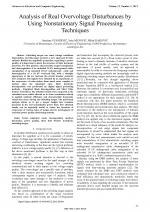| 3/2015 - 4 |
Analysis of Real Overvoltage Disturbances by Using Nonstationary Signal Processing TechniquesVUJOSEVIC, S. |
| Extra paper information in |
| Click to see author's profile in |
| Download PDF |
Author keywords
empirical mode decomposition method, harmonics, power quality, short time Fourier transform, switching surges
References keywords
power(22), quality(10), analysis(10), time(7), transmission(5), systems(5), line(5), vujosevic(4), upec(4), system(4)
Blue keywords are present in both the references section and the paper title.
About this article
Date of Publication: 2015-08-31
Volume 15, Issue 3, Year 2015, On page(s): 23 - 32
ISSN: 1582-7445, e-ISSN: 1844-7600
Digital Object Identifier: 10.4316/AECE.2015.03004
Web of Science Accession Number: 000360171500004
SCOPUS ID: 84940747691
Abstract
Switching surges can cause voltage conditions degradation, and this paper presents a new approach in their analysis. Besides the amplitude properties, regarding to power quality, it is important to know the structure of their harmonic spectrum. For that purpose, characteristic surges (energization and deenergization of an unloaded 35 kV underground cable, energization of an unloaded 10 kV underground cable and deenergization of a 10 kV overhead line, with a multiple appearance of the arc between the circuit breaker contacts) were analyzed. The signals were obtained by an experiment, so the occurrence of noise makes them much more complex to analyze than the simulated ones. Their harmonic decomposition was performed by digital signal processing methods - Empirical Mode Decomposition and Short Time Fourier Transform. The obtained results were compared to the calculated ones, which allowed us to draw conclusions related to applied methods efficiency and characteristic harmonics values that occur during the switching surges. The performed analysis allows us to get a deeper insight into transient processes in the real transmission power lines. The obtained results can be especially useful to detect the locations of occurrence of various types of surges and for development of real-time power quality monitoring systems. |
| References | | | Cited By |
Web of Science® Times Cited: 1 [View]
View record in Web of Science® [View]
View Related Records® [View]
Updated 2 weeks, 5 days ago
SCOPUS® Times Cited: 1
View record in SCOPUS® [Free preview]
View citations in SCOPUS® [Free preview]
[1] Detection of physical signal and time-frequency analysis owing to the impact on rubber material using a piezoelectric sensor, Hiremath, Shivashankar, Kim, Tae-Won, Journal of Mechanical Science and Technology, ISSN 1738-494X, Issue 5, Volume 38, 2024.
Digital Object Identifier: 10.1007/s12206-024-0424-2 [CrossRef]
Disclaimer: All information displayed above was retrieved by using remote connections to respective databases. For the best user experience, we update all data by using background processes, and use caches in order to reduce the load on the servers we retrieve the information from. As we have no control on the availability of the database servers and sometimes the Internet connectivity may be affected, we do not guarantee the information is correct or complete. For the most accurate data, please always consult the database sites directly. Some external links require authentication or an institutional subscription.
Web of Science® is a registered trademark of Clarivate Analytics, Scopus® is a registered trademark of Elsevier B.V., other product names, company names, brand names, trademarks and logos are the property of their respective owners.
Faculty of Electrical Engineering and Computer Science
Stefan cel Mare University of Suceava, Romania
All rights reserved: Advances in Electrical and Computer Engineering is a registered trademark of the Stefan cel Mare University of Suceava. No part of this publication may be reproduced, stored in a retrieval system, photocopied, recorded or archived, without the written permission from the Editor. When authors submit their papers for publication, they agree that the copyright for their article be transferred to the Faculty of Electrical Engineering and Computer Science, Stefan cel Mare University of Suceava, Romania, if and only if the articles are accepted for publication. The copyright covers the exclusive rights to reproduce and distribute the article, including reprints and translations.
Permission for other use: The copyright owner's consent does not extend to copying for general distribution, for promotion, for creating new works, or for resale. Specific written permission must be obtained from the Editor for such copying. Direct linking to files hosted on this website is strictly prohibited.
Disclaimer: Whilst every effort is made by the publishers and editorial board to see that no inaccurate or misleading data, opinions or statements appear in this journal, they wish to make it clear that all information and opinions formulated in the articles, as well as linguistic accuracy, are the sole responsibility of the author.



